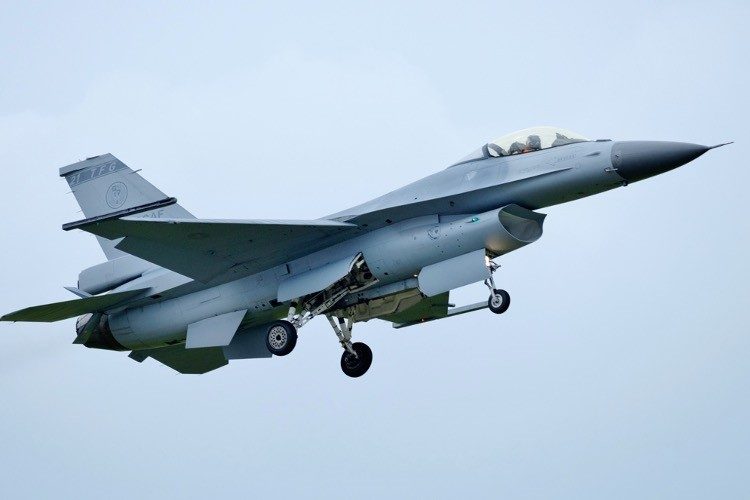
The U.S. State Department has given the green light for the potential sale of $428 million in aircraft parts for Taiwan to enhance its air force, which is under pressure due to constantly intercepting Chinese jets operating near the self-ruled island.
Taiwan’s air force is well-equipped but aging, and pales in comparison to China’s.
Beijing regards Taiwan as its territory and, during the past three years or so, has been operating military flights near Taiwan.
After the visit to Taipei by House Speaker Nancy Pelosi in August, China ramped up its war games to display its unhappiness toward Taiwan. Moreover, China’s air force has also frequently trespassed the median line of the Taiwan Strait, which has functioned as an unofficial boundary.
On December 6, the Pentagon announced in two statements that the parts would support Taiwan’s F-16s, Indigenous Defense Fighter jets, and all other aircraft and systems or subsystems of U.S. origin.
“The proposed sale will contribute to the sustainment of the recipient’s aerial fleet, enhancing its ability to meet current and future threats while providing defensive and transport capabilities critical to regional security,” it said.
In response, Taiwan’s Defence Ministry on Wednesday said the sale was slated to take effect within one month, and expressed its gratitude.
With China trying to “normalize” its military activities near Taiwan and put pressure on Taiwan’s airspace and seas, the sale will be of huge benefit, the ministry said.
It will “help maintain the proper equipment and replenishment of our air force’s fighter jets, meet the needs of defense operations and combat readiness training, and ensure that our traditional combat power will not fall,” it said.
The United States is Taiwan’s most vital international arms supplier, despite not having formal diplomatic ties with the small island nation. China has persistently criticized the United States for selling weapons to Taiwan and has imposed sanctions on U.S. arms manufacturers.
Earlier this year, Taiwanese President Tsai Ing-wen indicated that China is conducting “cognitive warfare” by propagating misinformation in addition to its regular military incursions into nearby waters and airspace, in order to cow Taiwan into submission.
To add to Taiwanese worries, observers have cautioned that China has had a considerable influence on Taiwanese mass media and could spread false narratives in social media and elsewhere to lower military morale and public confidence should it act on its threat to use force to take control of Taiwan.
“The situation around the Taiwan Strait continues to be tense, and the threat has never ceased,” Tsai declared in a speech while at an air defense and missile battalion in the eastern country of Hualien.
“In addition to frequent intrusions by China’s aircraft and ships, China also conducted cognitive warfare, using false information to create disturbance in the minds of people,” Tsai said.
Tsai also alluded to China’s use of drones “to increase pressure on Taiwan’s military,” after Taiwanese troops based on islands just off the Chinese coast warned off Chinese drones. Furthermore, Taiwanese troops in one case shot down unmanned aerial vehicles that had been loitering over their positions.
In September of this year, it was announced that anti-drone defenses were to be included in a 12.9-percent rise in Taiwan’s defense budget for 2023. The increase would raise total spending to $13.8 billion, or roughly 2.4 percent of GDP.
Taiwan also conducted military exercises on the Hengchun Peninsula in the far south of the island, simulating ground warfare against an invading enemy assisted by Apache attack helicopters.
“We will continue to hold the attitude of being prepared for war,” Lieutenant Colonel Jing Feng-huang told reporters at the site of the drills. “We will not shy away from war but will not seek it out.”
The exercises started with snipers firing at targets, followed by two Apaches blasting away at hillside targets. Troops also fired rounds from M109 howitzers and 105mm armored vehicle assault guns, as well as Javelin anti-tank weapons that have proven highly effective against Russian armor in the Ukraine conflict. Some analysts have even compared the Ukraine crisis to a potential Chinese attack on Taiwan.
Although the exercises are routine and organized multiple times a year, the media were granted an unprecedented degree of access, possibly as a message to China during the present tensions.
Besides boosting Taiwan’s high-tech economy, Tsai will work on bolstering the island’s defenses during her second, and last, four-year term in office. Enhancing Taiwanese defenses include beefing up the domestic defense industry and obtaining more weaponry from the United States, such as fighter jets and missiles, to counter a potential Chinese attack or attempted blockade.
Earlier this year, the Biden administration declared a $1.09 billion sale, including $355 million for Harpoon air-to-sea missiles and $85 million for Sidewinder air-to-air missiles, the State Department said.
The greatest part of the sale is a $655 million logistics support package for Taiwan’s surveillance radar program that offers air-defense warnings. Early-warning air-defense systems have become more crucial amid the increase in Chinese military drills near Taiwan.
As for China, its Defense Ministry lambasted Washington for “making trouble,” adding, “We demand that the U.S. side immediately withdraw the above-mentioned arms sales plan to Taiwan and immediately cease military ties between the U.S. and Taiwan.” “The Chinese People’s Liberation Army continues to train and prepare for war and will resolutely thwart any interference by an external force and separatist ‘Taiwan independence’ plots,” the Chinese ministry said in a statement on its website.



